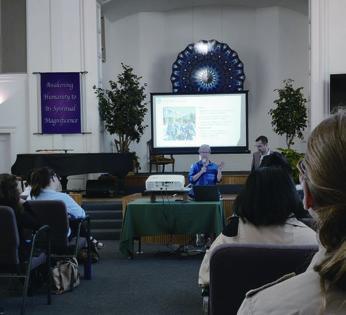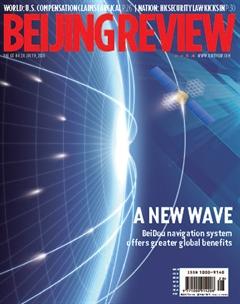Educational Strain
By Sherry Qin


The tensions between China and the U.S. in the past two years have spilled over into the educational realm. On June 1, certain groups of Chinese post-graduate students and post-doctoral researchers were banned from entering the U. S. on the allegation of acquiring “sensitive U.S. technologies and intellectual property,” in part to bolster the modernization and capability of the Peoples Liberation Army, according to an executive order signed by President Donald Trump.
The New York Times estimated that about 3,000 to 5,000 people, accounting for about 1 percent of the Chinese students studying in the U.S., would be affected.
The new ban is stark political persecution and racial discrimination, which constitutes a grave violation of the legitimate rights and interests of Chinese students and researchers in the U.S., according to Chinese Foreign Ministry spokesperson Zhao Lijiang. “It runs counter to the openness and freedom the U.S .claims to champion and the public commitment given by the U.S. leader,” Zhao said at a press conference in Beijing on June 1.“It goes against the trend of the times in international talent exchange. This will gravely impact the normal cultural and personnel exchange between the two countries.”
He urged the U.S. to stop using unfounded excuses to restrict and oppress Chinese students and researchers in the country.
“Our government has shifted from the principles of engagement for the last 40 years to principles that seem to want to restrict, control and confront,” said Michael Brzezinski, Dean of International Programs of Purdue University, at a webinar on June 24, which gathered professors and international relations experts to discuss current challenges to China-U.S. educational collaboration.
“We urge our leaders to further consider the extraordinary values our international scholars bring to advance our national interests through their important contributions at our colleges and universities and to allow them continued participation in our educational institutions,” Andrew Martin, Chancellor of Washington University at St. Louis, said at the event.
Politicized academia
Since the Peoples Republic of China and the U. S. established diplomatic relations in 1979, the number of students from the Chinese mainland to the U.S. has surged. Currently, it is the largest source of international students in the U.S., accounting for nearly 370,000 of this group in 2019, according to Xinhua News Agency reports.But the Trump administrations broad antagonism toward China is causing uncertainties for educational exchanges between the two counties. Beginning in 2019, it has expanded the targets of its decoupling-fromChina strategy from business and technology to students and researchers, asking the immigration authorities to tighten Chinese student visa rules.
Actually, the growth rate for Chinese students at universities in the U.S. has declined in recent years amid reports of visa restric- tions, according to the U.S.-based Institute of International Education.
Brzezinski said, “Administrators and faculty within higher education have often been apolitical, enjoying the benef its of the fl ow of talent to and from China. But its national policies of the governmental level that determine the fl ow of talent across national borders.”
“Unfortunately the academic community in America at the moment has relatively little infl uence on the regime and in Washington,”Philip Altbach, founding Director of the Center for International Higher Education at Boston College, said.
After the ban on Chinese graduate students and scholars, the Trump administration on June 22 dropped another bombshell by temporarily suspending work visas, which include J visas for exchange scholars. Such a sweeping policy, which is allegedly aimed at leading an America First recovery from the pandemic, restricts a large number of foreign professionals, not limited to Chinese nationals, to work in the U.S.
Pandemic impact
The novel coronavirus disease (COVID-19) pandemic has also created challenges for Chinese students studying or planning to study in the U.S. Coronavirus-led delays in U.S. college entrance exams in China and indefi -nite travel restrictions are making them think twice about pursuing higher education on the other side of the Pacifi c. Their concerns also include the Trump administrations ineffective response and anti-racism protests in the U.S.“There is a general feeling among families that the U.S. may not be safe at the moment and I think those feelings particularly relating to the COVID-19 are largely justifi ed,” Altbach said.
While China has had the pandemic under control, the U.S. continues to see single-day records of new COVID-19 cases, with over 50,000 infections reported on July 1. Many Chinese students who are already halfway through their studies in the U.S. and currently back in China are pondering if they should go back to the campus in the fall.
“My parents want me to stay until it is fully under control,” Jasmine Yin, a Chinese student studying in New York City, told Beijing Review. “I dont know, probably I will take a year off.”
Some of them have been consulting with their schools on possibilities to study in partner universities in China without having to take a semester off.
Qing He, a consultant at Jinjilie, an overseas study consulting services agency in China, said in an article that the pandemic has reduced Chinese families enthusiasm for sending children abroad. The travel restrictions, the anti-Asian sentiment in the U.S. and economic pressure after months of lockdown have all weighed on Chinese families decisions. At the end of March, the company predicted an 8-percent fall in the number of Chinese students applying for studying in the U.S. in the 2020-21 academic year and said the drop might be deeper if the epidemic couldnt be brought under control in the U.S.
A Jinjilie report released in June gauged the sentiment among families that had plans to send their children abroad. “Many families held back their plans because they were concerned about the safety and the rising xenophobia in Western countries,” it said.
The uncertainties forward, from a highly possible second wave of coronavirus to the U.S. domestic political situation after the presidential election in November, may be the new hurdles for studying in the U.S.
The positive factor
After countries around the world imposed lockdowns to contain the spread of the COVID-19, Zoom, a video conferencing app, has become popular among people working from home. Zooms founder, Eric Yuan, a Chinese American who owns about 20 percent of the multi-billion-dollar business, was born and raised in Shandong Province, east China. He went to the U.S. in 1997 and earned an MBA from Stanford University in 2006.Another billionaire, Colin Huang, the founder of Pinduoduo, a Chinese ecommerce platform, recently became the second richest man in China after Tencents Pony Ma. Huang earned a masters degree from the University of Wisconsin and then worked for Google for a decade before founding Pinduoduo in 2015.
Both Yuan and Huang are the benefi ciaries of China-U.S. educational exchanges.
With China-U.S. relationship at its lowest point in decades, participants in the webinar agreed that higher education can be the glue to bring them together.
“We are educating a new generation of people who will not only contribute to China or the U.S. but to humankind,” Yawei Liu, Director of the China Program at the Carter Center, said.
There are a lot of misunderstandings given the cultural and institutional differences between China and the U.S., but Jia Qingguo, a professor and former dean of the School of International Studies at Peking University, stressed that educational exchanges help mutual understanding.
While the pandemic has created more setbacks for China-U.S. educational exchanges, Brzezinski thinks it might be an opportunity as well: “You will see a proliferation of virtual collaboration programs, probably because of COVID-19.”

